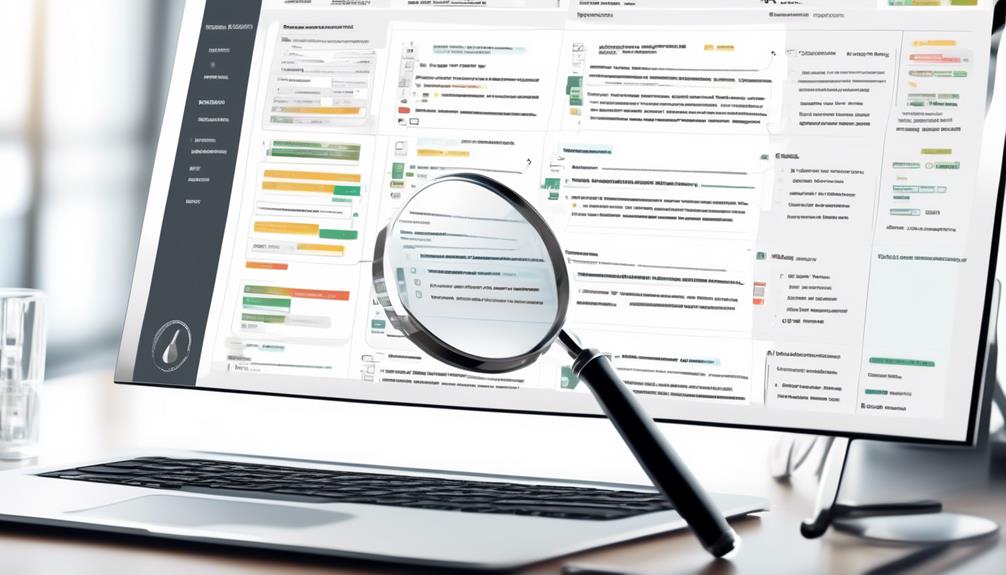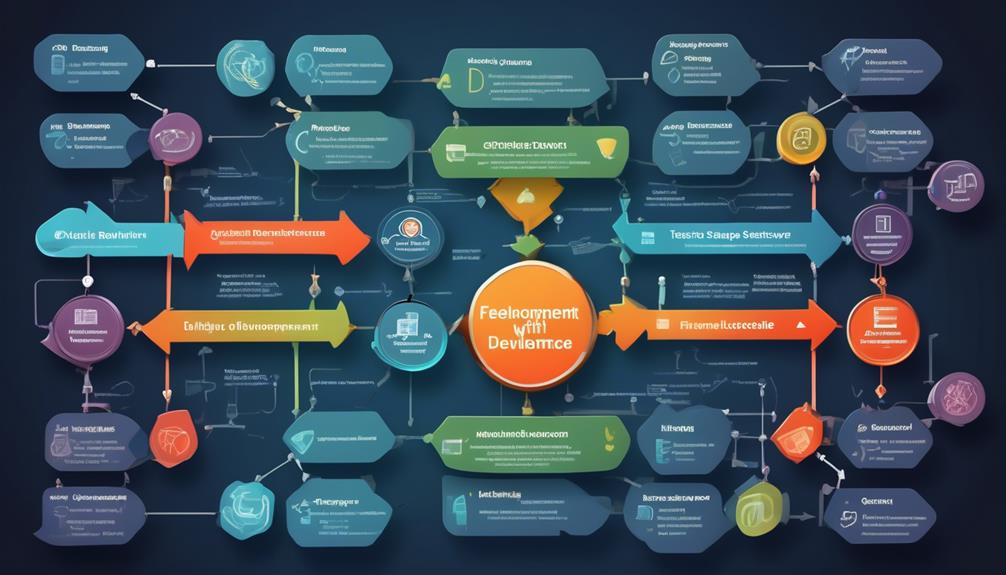SQA Best Practices
QA Assessment Test
Prepare for your QA assessment test with our comprehensive guide. Learn about the different types of assessment tests and how to excel in your QA assessment.

As we all are aware, software is analogous to a intricate jigsaw puzzle, and guaranteeing its quality involves ensuring each piece fits seamlessly.
Recently, I came across an intriguing topic that has been gaining traction in the tech industry—the QA Assessment Test.
It's not just another standard evaluation; this test has been designed to gauge candidates' proficiency in software quality assurance, covering everything from designing functional tests to creating optimized test cases.
What makes it so crucial in today's competitive job market? Well, let's just say it's more than just a certification—it's a validation of expertise that can significantly impact a candidate's career trajectory.
So, what exactly sets this assessment apart?
Key Takeaways
- QA assessment tests are effective tools for evaluating candidates' proficiency in QA and their ability to design functional tests.
- A well-designed evaluation process should incorporate work-sample tasks, cover all cases including corner cases, and assess understanding of different types of testing.
- There are various QA assessment tests available, such as the Software Quality Assurance Online Test and the QA Skills Test for Pre-Employment Screening, which measure different aspects of QA proficiency.
- Recruiters and hiring managers value individuals who can create test plans and implement QA processes, and possessing advanced skills in test development and diverse test types is highly desirable.
Benefits of QA Assessment Tests

I will present the benefits of QA assessment tests, highlighting their impact on evaluating and certifying candidates' skills in software quality assurance.
QA assessment tests play a crucial role in the evaluation and certification of candidates' proficiency in Quality Assurance (QA). These tests assess various aspects, including a candidate's ability to design functional tests, follow testing procedures, and optimize test cases. They ensure that candidates are capable of utilizing different techniques to cover all cases, including corner cases, and demonstrate the capacity to design effective and efficient tests.
The benefits of QA assessment tests extend to both job seekers and companies. Job seekers can use these tests to practice their skills, earn certificates, and prepare for certification tests in software quality assurance. On the other hand, companies can leverage these tests to evaluate candidates with real-world problems, streamline their hiring process, and access premium questions that can't be practiced to assess candidates effectively.
Ultimately, QA assessment tests provide a comprehensive evaluation of candidates' capabilities in the testing process, offering significant benefits to both candidates and recruiters.
Designing an Effective Evaluation Process

To ensure a comprehensive assessment of candidates' skills in software quality assurance, designing an effective evaluation process is essential.
The evaluation process should incorporate work-sample tasks that assess the ability to design functional tests and follow testing procedures. It needs to cover all cases, including corner cases, and demonstrate the ability to design effective and efficient tests. This includes ensuring that the software works as expected and covers key concepts and techniques behind test development.
Additionally, the process should evaluate the understanding of different types of testing and the creation of optimized test cases. It's crucial to gauge the ability to use different techniques to ensure comprehensive test coverage.
By including these elements in the evaluation process, we can effectively evaluate candidates' skills in QA and testing, making it an integral part of the recruitment process for software quality assurance roles.
This thorough and detailed evaluation process ensures that candidates possess the necessary skills and knowledge to excel in software quality assurance roles, contributing to the overall success of the QA team.
Software Quality Assurance Online Test
In continuing our exploration of software quality assurance, the Software Quality Assurance Online Test offers an opportunity to assess and validate candidates' abilities in designing functional tests and following testing procedures. The assessment helps evaluate a candidate's knowledge and skills in QA, particularly in Test Design and engineering tests. Below is a table that highlights the key areas evaluated in the Software Quality Assurance Online Test:
| Assessment Areas | Description |
|---|---|
| Test Design | Evaluates the candidate's ability to design effective and comprehensive test cases. |
| Testing Procedures | Assesses the candidate's understanding of testing processes and adherence to best practices. |
| QA Skills | Measures the candidate's proficiency in quality assurance methodologies, tools, and techniques. |
| Functional Test Design | Tests the candidate's capability to design test cases that validate the functionality of software applications. |
The Software Quality Assurance Online Test is an essential tool for organizations seeking to hire competent QA engineers and for individuals looking to validate their expertise in Software Quality Assurance.
QA Skills Test for Pre-Employment Screening

Let's examine the assessment criteria and test format for the QA skills test.
Understanding what the assessment will focus on and the format of the test is crucial for preparation. We need to ensure that we're familiar with the specific points that will be evaluated and the structure of the test to perform at our best.
Assessment Criteria
Certainly!
Regularly, our Assessment Criteria for the QA Skills Test for Pre-Employment Screening ensures a comprehensive evaluation of candidates' skills in software testing and QA.
The test evaluates a candidate's ability to design functional tests, follow testing procedures, and create optimized test cases. Test takers must demonstrate their understanding of different types of testing and use various techniques to cover all cases, including corner cases, to design effective and efficient tests.
The assessment ensures that candidates possess the necessary skills to assess the quality of software and covers key concepts and techniques behind test development in software development.
Our assessment criteria are designed by subject matter experts to provide an in-depth evaluation of candidates' capabilities, ensuring that only the most qualified individuals are selected for QA testing roles.
Test Format
Our Assessment Criteria for the QA Skills Test for Pre-Employment Screening ensures a comprehensive evaluation of candidates' skills in software testing and QA.
Now, turning our focus to the Test Format. The test assesses candidates' ability to design functional tests, use different techniques to cover all cases, understand different types of testing, and create optimized test cases. These skills are essential for ensuring the quality of products in web development and software systems.
The format is experts-based and aims to evaluate the candidate's capability to adequately test the software system. By incorporating these elements, the pre-employment test aims to assess the candidate's ability to contribute to the quality of the final product.
QA Assessment Test (Advance Level)

As we continue to explore the topic of QA Assessment Test (Advance Level), it's crucial to focus on the specific points related to advanced skills and test types.
Understanding the nuances of different testing methodologies and being able to create optimized test cases are essential for excelling in this advanced level assessment.
We'll delve into the details of these key points to provide a comprehensive understanding of what it takes to succeed in the QA Assessment Test at an advanced level.
Test Types
Covering all aspects of software functionality, the QA Assessment Test (Advance Level) evaluates the ability to design and implement diverse test types using various techniques.
The following types of tests are crucial in assessing a candidate's expertise:
- Unit Testing: Evaluating individual units or components of the software.
- Integration Testing: Testing the interaction between integrated components.
- System Testing: Validating the entire software system's functionality.
- Acceptance Testing: Ensuring the software meets the business requirements and is ready for delivery.
Recruiters and hiring managers seek individuals who can effectively create a test plan and implement Quality Assurance processes within the development team. Demonstrating proficiency in these test types is essential for a successful career as a QA engineer or software developer.
Advanced Skills
Proficiency in the various test types, as covered in the previous subtopic, serves as a foundation for the Advanced Skills QA Assessment Test (Advance Level), which evaluates the ability to design functional tests and follow testing procedures. Test takers are expected to demonstrate mastery in using different techniques to cover all cases, including corner cases.
This assessment includes work-sample tasks such as understanding various testing types and creating optimized test cases. An effective QA tester or software developer should possess the skills to design efficient tests and ensure the software works as expected.
The test evaluates a candidate's ability to identify the best concepts and techniques behind test development, emphasizing the importance of Quality Assurance in achieving reliable and effective software. It's crucial to showcase advanced skills in test development to ensure comprehensive test coverage and the creation of optimized test cases.
Quality Assurance Aptitude Test Overview

The Quality Assurance Aptitude Test Overview provides a comprehensive assessment of the ability to design functional tests and follow testing procedures for software quality assurance. This evaluation ensures candidates understanding of different types of testing, including box testing, and their capability to create optimized test cases.
The assessment also includes the creation of custom questions and the development of effective and efficient automated tests. Moreover, the test evaluates the test data and the test execution process, covering key concepts and techniques behind test development. It ensures that the software works as expected and that test takers can use different techniques to cover all cases, including corner cases.
A good QA tester or software developer should be able to demonstrate their aptitude in these areas to design effective and efficient tests.
Tricky QA Interview Questions and Answers

Understanding the difference between Quality Assurance and Software Testing is crucial, especially when facing tricky QA interview questions. It's essential to showcase a deep understanding of project management, digital marketing, and the impact of QA on product quality and user experience. Here are some common tricky QA interview questions and their answers:
| Tricky Question | Answer |
|---|---|
| How do you ensure product quality? | I focus on comprehensive test planning and leveraging testing tools to identify and address any potential issues. |
| What role does QA play in hiring decisions? | QA ensures that the product meets the required standards, contributing to the overall success of the organization. |
| How do you handle video questions in testing? | I thoroughly test video functionality, ensuring it meets the desired specifications and user expectations. |
| Can you explain the importance of user experience in testing? | User experience is paramount, and QA plays a crucial role in ensuring that the product meets user expectations and is easy to use. |
These questions and answers demonstrate a strong grasp of QA concepts, project management, and their application in real-world scenarios.
Test Automation Made Easy

Test Automation Made Easy simplifies the process of setting up and executing automated tests, providing user-friendly interfaces and comprehensive documentation.
With this platform, developing software becomes more efficient, allowing us to select the tests needed for our software product with ease.
Test Automation Made Easy offers a wide range of testing tools for both functional and non-functional testing, enabling us to ensure the quality and reliability of our software products.
Moreover, it supports integration with various development tools, making the entire testing process seamless and well-integrated with our existing workflows.
This streamlines the testing process, allowing our team to focus on delivering quality software products.
Frequently Asked Questions
What Is Assessment in Qa?
Assessment in QA involves designing functional tests and following testing procedures. We must understand different types of testing and create optimized test cases. Using different techniques to cover all cases, including corner cases, is crucial.
A good QA tester or software developer should demonstrate their ability to design effective and efficient tests. This ensures that software works as expected and covers key concepts and techniques behind test development.
What Is a QA Test?
We understand the importance of a QA test in ensuring the reliability and functionality of software.
It's a comprehensive assessment that evaluates a tester's ability to design effective and efficient tests, covering all cases including corner cases.
Through this test, individuals demonstrate their understanding of different testing techniques and their capability to create optimized test cases.
Ultimately, it ensures that the software works as expected and covers key concepts and techniques behind test development.
How Hard Is QA Testing?
QA testing can be challenging because it requires a deep understanding of software functionality and the ability to design comprehensive tests. We need to consider various factors, including different testing techniques and corner cases, to ensure thorough coverage.
It demands a high level of attention to detail and thoroughness. However, with the right skills and dedication, we can effectively navigate the complexities of QA testing and ensure that the software works as expected.
How Do I Do a QA Manual Test?
To do a QA manual test, we meticulously follow test cases to validate software functionality. Attention to detail is key as we execute each step, documenting any deviations from expected results. Thoroughness ensures comprehensive coverage, identifying potential defects.
Clear communication of findings is imperative for resolution. It's a methodical process, akin to carefully assembling a complex puzzle. Each piece must fit perfectly to ensure the software meets quality standards.
Conclusion
In conclusion, the QA Assessment Test is a valuable tool for both jobseekers and companies in the software industry.
It provides a comprehensive evaluation of skills and knowledge in software quality assurance, helping individuals improve their expertise and companies streamline their hiring process.
Just like a well-crafted test case, the QA Assessment Test ensures that candidates are thoroughly checked for their abilities, like a fine-toothed comb through code.
At the helm of our content team is Amelia, our esteemed Editor-in-Chief. Her extensive background in technical writing is matched by her deep-seated passion for technology. Amelia has a remarkable ability to distill complex technical concepts into content that is not only clear and engaging but also easily accessible to a wide range of audiences. Her commitment to maintaining high-quality standards and her keen understanding of what our audience seeks are what make her an invaluable leader at EarnQA. Under Amelia’s stewardship, our content does more than just educate; it inspires and sets new benchmarks in the realm of QA education.
SQA Best Practices
Unlock the Secrets of Software Quality Assurance: Best Practices and Benefits
Software Quality Assurance ensures that the software meets the highest standards. It involves testing, bug identification, and ensuring the software performs as expected.

We all are aware of how troublesome software bugs can be, causing a significant impact globally with a staggering **$1.1 trillion** annually. However, let’s take a moment to discuss Software Quality Assurance (SQA). What exactly is its importance?
Well, it's not just about finding and fixing bugs. SQA encompasses a comprehensive approach to ensuring that the software meets quality standards at every stage of its development.
But what exactly does this process entail, and why is it so crucial in today's tech-driven world?
Join me as we explore the intricacies of SQA and unravel its significance in delivering reliable, high-quality software solutions.
Key Takeaways
- Software Quality Assurance (SQA) ensures software meets quality standards at every stage of its life cycle
- SQA goes beyond error identification and includes creating an SQA plan
- SQA aims to prevent defects from occurring and reduces the risk of errors and defects
- SQA upholds quality standards, saves time and costs, and enhances software stability and competitiveness
Definition of Software Quality Assurance
In software development, the term 'Software Quality Assurance' refers to the meticulous process of ensuring that the software meets predetermined quality standards at every stage of its life cycle. Software Quality Assurance (SQA) is an integral part of the software development process, working in parallel to ensure that the product meets established quality specifications. It involves a comprehensive approach to quality, aiming to catch and rectify any potential shortcomings before the software is released to the public.
SQA goes beyond mere error identification, encompassing a broad range of quality aspects. It includes creating an SQA plan, setting checkpoints for regular quality inspections, deploying software engineering techniques to ensure high-quality specifications, conducting formal technical reviews, and utilizing a multi-testing strategy. The primary goal of SQA isn't only to detect defects but also to prevent them from occurring in the first place.
Moreover, SQA extends its focus beyond software testing to ensure the software's portability, usability, reusability, correctness, and maintainability. This detailed approach to quality assurance is vital in the software development process, as it ultimately impacts the reliability and success of the final product.
Key Components of Software Quality Assurance

Key components of Software Quality Assurance encompass:
- Applying a comprehensive quality management approach to ensure adherence to established standards throughout the software development process.
- Formal technical reviews play a crucial role in evaluating the design and quality of the software, identifying and addressing any issues that may arise.
- A multi-testing strategy is essential, utilizing various testing approaches to comprehensively test the software and ensure its quality.
- Effective software engineering technology is a critical component, employing advanced techniques to achieve high-quality specifications and meet standards for software quality attributes.
- The implementation of a robust measurement and reporting mechanism is vital, providing a means to track and report on the quality of the software throughout the development process.
Each of these components plays a significant role in the Software Quality Assurance Plan, ensuring that quality is a fundamental aspect of all software development processes, activities, and management within a project. This ultimately leads to high-quality software products.
Importance of Software Quality Assurance
Building on the foundation of key components in Software Quality Assurance, the importance of SQA in ensuring high-quality software products can't be overstated. SQA plays a pivotal role in upholding quality standards and ensuring that software meets customer expectations. By implementing rigorous software testing and a defect management approach, SQA significantly reduces the risk of errors and defects, ultimately saving time and costs while enhancing the stability and competitiveness of the software product.
Throughout the Development Life Cycle (SDLC), SQA is crucial for maintaining quality management, continuously monitoring, and improving the software. It not only enhances the efficiency and reliability of the software but also contributes to its maintainability, usability, and portability. Moreover, SQA is essential for safeguarding the reputation and credibility of a business, as it ensures security, compliance, and customer satisfaction.
The responsibilities of SQA encompass various critical aspects, including adherence to quality standards, comprehensive testing, and effective defect management. By fulfilling these responsibilities, SQA significantly contributes to the overall success of software development, thereby emphasizing its indispensable importance in the software industry.
Implementation of Software Quality Assurance

Implementing Software Quality Assurance requires a meticulous approach to ensure that established quality specifications are consistently met throughout the software development life cycle. It involves setting up standards and procedures for quality assurance and quality control.
This implementation process requires careful planning, as it encompasses various activities such as formal technical reviews, multi-testing strategies, and the use of advanced software engineering techniques. The implementation of SQA also involves creating an SQA plan that outlines the checkpoints for regular quality inspection and identifies the responsibilities of each team member in maintaining quality standards.
Additionally, it requires a systematic approach to integrate quality assurance and quality control into the daily work of software development. This includes utilizing tools and methodologies that enable continuous monitoring and improvement of the software quality.
Difference Between Quality Assurance and Testing
Quality assurance and testing serve distinct purposes in the software development process, each with its own specific focus and objectives.
Quality assurance (QA) primarily concentrates on ensuring that software meets established quality specifications, encompassing ongoing processes that run parallel to software development to check for quality issues in each phase. It aims to catch product shortcomings before the public sees them, covering activities like creating an SQA plan, setting checkpoints for regular quality inspection, and conducting formal technical reviews to evaluate design and quality.
On the other hand, testing is a specific phase focused on identifying and reporting bugs. Its primary goal is to find errors, and it may or may not involve addressing and solving identified errors. While QA encompasses a multi-testing strategy for comprehensive testing, testing itself is focused on finding errors in the software.
Frequently Asked Questions
What Does Software Quality Assurance Consist Of?
Software Quality Assurance consists of several key components.
First, there is the creation of a plan, which outlines the overall approach to quality assurance for a software project. This plan may include details on inspection checkpoints, engineering techniques, and formal reviews that will be used throughout the development process.
The second component is the implementation of this plan. This involves carrying out the inspection checkpoints, deploying the engineering techniques, conducting the formal reviews, and ensuring that all steps are followed according to the plan.
The third component is the multi-testing strategy. This strategy involves testing the software from various angles and perspectives to ensure that it meets the required quality standards.
SQA also covers various aspects of software quality, including portability, usability, reusability, correctness, and maintainability. These factors are important in ensuring that the software is not only functional but also reliable and easy to use.
Overall, SQA aims to catch any shortcomings in the software before it is released to the public. By resolving errors and ensuring that the software meets the necessary quality standards, SQA helps to improve the overall user experience and satisfaction.
To achieve these goals, a quality management approach is necessary. This approach ensures that all aspects of SQA are properly managed and executed. It also includes formal technical reviews, which provide a structured and systematic way to assess the software's quality.
In addition, effective software engineering technology is key to successful SQA. This technology includes tools and techniques that aid in the development, testing, and evaluation of software products.
Measurement and reporting mechanisms are also important components of SQA. These mechanisms allow for the monitoring and tracking of the software's quality throughout the development process. They provide valuable insights into the effectiveness of the SQA efforts and help to identify areas for improvement.
What Is the Role of a Quality Assurance Software?
The role of Quality Assurance Software is to ensure the software meets established quality specifications throughout the development process.
It works parallel to software development, checking for quality issues in each phase and aims to catch product shortcomings before public release.
Our team creates an SQA plan, sets checkpoints for regular quality inspection, deploys software engineering techniques, conducts formal technical reviews, and employs a multi-testing strategy to uphold quality standards.
What Do You Mean by Quality Assurance?
Quality assurance ensures that products meet established quality standards throughout the development process. It goes beyond simple error detection, aiming to solve issues and prevent them from reaching the public.
An interesting statistic is that SQA can reduce production costs by up to 50% and prevent up to 90% of potential issues.
This meticulous process involves creating a solid SQA plan, regular quality inspections, and comprehensive testing to ensure high-quality software that meets client expectations.
What Is an Example of Quality Assurance in Software?
An example of quality assurance in software is ensuring the usability, portability, correctness, maintainability, and reusability of the software product.
We achieve this by:
- Creating an SQA plan
- Setting checkpoints for regular quality inspection
- Deploying software engineering techniques
- Conducting formal technical reviews
- Utilizing a multi-testing strategy
Our approach involves:
- Auditing
- Reviewing
- Code inspection
- Design inspection
- Simulation
These techniques are used to ensure software quality.
Conclusion
In the world of software development, Software Quality Assurance is like the meticulous gardener who carefully tends to each plant, ensuring that they grow strong and vibrant.
It involves constant monitoring, inspection, and problem-solving to ensure that the final product meets the highest quality standards.
Just as a master chef carefully tastes and adjusts their dish, SQA ensures that software is flawless and ready to delight its users.
Rick, our Software Quality Assurance Writer, is the creative force behind many of our insightful articles and course materials. His unique background in software development, fused with his natural flair for writing, allows him to convey complex QA concepts in a way that is both informative and captivating. Rick is committed to keeping abreast of the latest trends and advancements in software testing, ensuring that our content remains not just relevant, but at the forefront of the field. His significant contributions are instrumental in helping us fulfill our mission to deliver premier QA education.
SQA Best Practices
Software Quality Assurance Audit Process Insights

Welcome to our conversation about the software quality assurance audit process. In the rapidly evolving digital landscape, software quality is a key element for any organization’s success. Conducting a software quality audit is essential to ensure that both software products and their development processes meet industry standards, follow best practices, and are free of vulnerabilities that could impact the software’s reliability.
Key Takeaways:
- A software quality audit evaluates software products and development processes to identify areas of improvement and ensure compliance with industry standards.
- Software Quality Assurance (SQA) focuses on preventing defects and maintaining desired quality standards throughout the software development lifecycle.
- Software audits involve an independent examination of software artifacts and practices to assess compliance and identify areas for improvement.
- A successful software quality audit requires clear objectives, thorough assessments, and implementation of necessary changes.
- Audit testing is crucial for evaluating software performance, ensuring compliance, and maintaining high-quality standards.
What is a Software Quality Audit?
In the world of software development, ensuring the delivery of high-quality products and services is paramount. This is where a software quality audit comes into play. A software quality audit is a comprehensive evaluation process that examines various aspects of software development to assess its adherence to quality standards, industry best practices, and organizational requirements.
A software quality audit encompasses elements of both Software Quality Assurance (SQA) and Software Audits. It goes beyond simply evaluating software functionality and delves deeper into the software development processes themselves. By conducting a thorough assessment, organizations gain valuable insights into the effectiveness and efficiency of their software development practices.
During a software quality audit, the entire software development lifecycle is scrutinized, including project planning, requirements management, coding, testing, and deployment. All aspects of the development process are thoroughly evaluated to identify any potential gaps or deficiencies.
A software quality audit is not just about finding bugs or defects in the software; it is about enhancing the overall quality of the software development processes.
By conducting an audit, organizations can ensure that their software development practices align with industry standards and best practices. This helps improve the overall quality of the software being developed and reduces the risk of critical issues occurring in the future.
Furthermore, a software quality audit provides organizations with a roadmap for continuous improvement. It offers valuable insights and recommendations for refining and optimizing the development processes, leading to increased efficiency and better outcomes.
Let’s take a closer look at the key components and scope of a software quality audit in the next section.
Software Quality Assurance (SQA)
In the realm of software development, ensuring a proactive approach towards quality is imperative. That’s where Software Quality Assurance (SQA) comes in. SQA is a systematic and proactive approach to preventing defects and ensuring that software meets the desired quality standards.
At every stage of the software development lifecycle, SQA plays a critical role. By implementing rigorous tasks and processes, SQA helps identify and address potential quality issues, ensuring that the end product meets both the organization’s internal standards and industry-wide quality benchmarks.
SQA encompasses a comprehensive range of activities such as:
- Requirements analysis and validation
- Design and code reviews
- Testing and test management
- Quality measurement and monitoring
- Defect prevention and control
The proactive nature of SQA sets it apart from other quality assurance approaches. Rather than just detecting and fixing defects after they occur, SQA actively seeks to prevent defects from happening in the first place. This proactive stance helps streamline the software development process, saving both time and resources.
By adhering to established quality standards and continually evaluating and refining the SQA process, organizations can ensure that their software products are reliable, secure, and perform optimally.

The image above visually represents the essence of Software Quality Assurance — the proactive approach to ensuring software quality throughout the development lifecycle.
SQA acts as a key gatekeeper, ensuring that software goes through a rigorous quality assurance process before it reaches end-users. This helps build trust and confidence in the software and establishes a solid foundation for success.
| Benefits of Software Quality Assurance | Objectives of Software Quality Assurance |
|---|---|
|
|
As demonstrated in the table, SQA brings multiple benefits to software development projects. By achieving its objectives, SQA assists organizations in delivering high-quality software that meets both the expectations of end-users and the demands of the competitive marketplace.
Software Audits
Software audits play a crucial role in ensuring the quality and compliance of software projects, processes, and products. Through retrospective assessments and independent examination, software audits help identify areas of improvement, verify compliance, and ensure adherence to best practices.
The Importance of Software Audits
Retrospective assessments provide valuable insights into the effectiveness of software development practices and strategies. By conducting independent examinations of software artifacts, documentation, and development practices, audits help organizations:
- Identify areas of improvement
- Verify compliance with industry standards
- Ensure adherence to best practices
Software audits are a vital part of quality assurance and compliance verification, enabling organizations to optimize their software development processes and enhance overall performance.
Components of a Software Audit
A comprehensive software audit typically includes the following components:
- Documentation review: Assessing the accuracy, completeness, and organization of software documentation.
- Code review: Examining the source code for quality, readability, and adherence to coding standards.
- Process review: Evaluating the software development processes to identify bottlenecks and inefficiencies.
- Security assessment: Analyzing the software’s security measures to identify vulnerabilities and potential risks.
- Compliance assessment: Ensuring the software complies with relevant laws, regulations, and industry standards.
By examining these key areas, software audits provide a holistic evaluation of the software’s quality and compliance.
Benefits of Software Audits
Software audits offer a range of benefits to organizations:
“Software audits provide valuable insights into the software’s quality and compliance, helping organizations identify and rectify deficiencies, improve overall performance, and mitigate risks.”
These assessments enable organizations to enhance their software development processes, optimize resource allocation, and ensure that their software meets the highest quality standards.

| Benefits of Software Audits | Description |
|---|---|
| Identification of deficiencies | Software audits help identify weaknesses and areas for improvement, allowing organizations to rectify them and enhance overall quality. |
| Assurance of compliance | Through compliance verification, software audits ensure that organizations meet regulatory and industry standards. |
| Risk mitigation | By identifying vulnerabilities and potential risks, software audits enable organizations to implement measures to mitigate those risks. |
| Process optimization | Software audits help optimize software development processes, enhancing efficiency and resource utilization. |
Key Components and Scope of a Software Quality Audit
In a software quality audit, several key components and activities are crucial for assessing and improving software quality. These components include:
- Planning: Establishing clear objectives, scope, and timelines for the audit.
- Documentation Review: Assessing the completeness, accuracy, and compliance of software-related documents such as requirements, design specifications, and test plans.
- Code Review: Evaluating the quality, readability, maintainability, and adherence to coding standards of the software’s source code.
- Process Review: Analyzing the software development and quality assurance processes to identify any inefficiencies or areas for improvement.
- Security Assessment: Assessing the software’s vulnerability to security threats and ensuring the implementation of appropriate security measures.
- Compliance Assessment: Verifying that the software conforms to industry standards, regulations, and relevant legal requirements.
By conducting these activities, a software quality audit provides a comprehensive assessment of various aspects of software development. It helps organizations identify weaknesses, improve processes, reduce risks, and ensure compliance with standards and regulations.
To illustrate the components and scope of a software quality audit, here is a sample table showcasing the different activities and their objectives:
Benefits of Software Quality Audits
Software quality audits offer numerous benefits that contribute to the improvement of software development processes, compliance, risk mitigation, and overall software quality. Through these audits, we can identify and remediate deficiencies, ensure compliance with industry standards, mitigate potential risks, and optimize our processes.
Identification and Remediation of Deficiencies: Software quality audits help us detect any shortcomings or weaknesses in our software products or development processes. By conducting a thorough evaluation, we can identify areas that require improvement and take appropriate measures to address them effectively.
Assurance of Compliance: Compliance with industry standards and regulations is of utmost importance for any software development organization. Software quality audits enable us to assess our compliance status, ensuring that our products meet the necessary criteria and adhere to established standards.
Risk Mitigation: Audits play a crucial role in identifying potential risks that may compromise the integrity or functionality of our software. By proactively identifying these risks, we can implement appropriate measures to mitigate them, safeguarding our software and protecting our stakeholders.
Process Optimization: Through software quality audits, we gain valuable insights into our development processes. We can identify areas where optimization is required and implement changes that enhance efficiency, productivity, and overall performance.
To illustrate the benefits of software quality audits, consider the following table:
Benefits Description Identification and Remediation of Deficiencies Identify and address weaknesses in software products and development processes. Assurance of Compliance Ensure adherence to industry standards and regulations. Risk Mitigation Identify and mitigate potential risks that may impact software integrity. Process Optimization Optimize software development processes for enhanced efficiency and productivity.

By leveraging the benefits of software quality audits, organizations can elevate their development standards, improve software quality, and ensure the delivery of reliable and high-performing software products.
Best Practices for Successful Software Quality Audits
To ensure the effectiveness and success of software quality audits, we recommend following these best practices:
- Establish Clear Objectives and Criteria: Clearly define the objectives and criteria for the audit. This will ensure that the assessment focuses on specific areas of concern and enables you to measure the software’s compliance with quality standards.
- Conduct a Thorough Assessment: In order to identify areas for improvement, thoroughly assess all aspects of the software development process, including documentation, code, testing, and security measures. Use a comprehensive approach to uncover any deficiencies and vulnerabilities.
- Implement Necessary Changes: Once deficiencies are identified, it is crucial to take action. Implement necessary changes to address the identified issues and improve the overall quality of the software. This could involve redesigning processes, refining documentation, enhancing security measures, or optimizing the code.
By following these best practices, you can establish a solid foundation for the audit process, ensure clear objectives and criteria, conduct a thorough assessment, and implement the necessary changes to enhance software quality.

Why is Audit Testing Important?
Audit testing is essential for several reasons:
- Compliance with defined standards: Audit testing verifies that the software follows industry standards and guidelines, ensuring that it meets the expected quality benchmarks.
- User satisfaction: By conducting thorough audit testing, we can identify and address any issues or shortcomings in the software that may affect the user experience. This, in turn, leads to improved user satisfaction.
- Ensuring software quality: Audit testing acts as a quality control mechanism, enabling us to detect and rectify any potential flaws or errors in the software before it is released to the end-users.
Types of Audit Testing
There are different types of audit testing, each serving a specific purpose:
Audit Testing Type Description Inquiry Obtaining information from relevant stakeholders through structured interviews or questionnaires. Observation Directly observing the software development and quality assurance processes to evaluate their effectiveness and adherence to standards. Examination Reviewing documentation, code, and artifacts to assess compliance and identify any deviations from best practices. Re-performance Repeating specific steps or actions within the software to ensure their accuracy and effectiveness. Computer-Assisted Audit Technique (CAAT) Using specialized software tools to automate audit procedures and analyze large volumes of data efficiently.
By employing these different types of audit testing, we can thoroughly evaluate the software’s development and quality assurance processes and identify areas that require improvement.
Overall, audit testing serves as a vital component of software quality assurance, enabling businesses to ensure compliance with defined standards, enhance user satisfaction, and deliver high-quality software products.
Importance of Audit Testing in Software Quality Assurance
Audit testing plays a crucial role in ensuring software quality assurance. By conducting comprehensive assessments, businesses can evaluate their compliance with industry standards, enhance user satisfaction, and maintain high software quality. This section explores the importance of audit testing in software quality assurance and its impact on overall software development.
The Benefits of Compliance with Standards
Compliance with standards is paramount in software development. Audit testing ensures that software products and processes adhere to industry standards, regulatory requirements, and best practices. It helps businesses identify any deviations from these standards and rectify them promptly. By maintaining compliance, businesses can build trust with their customers, partners, and stakeholders, while mitigating legal and reputational risks.
Enhancing User Satisfaction
User satisfaction is a critical measure of software success. Through audit testing, businesses can assess their software’s functionality, usability, and performance from the end-users’ perspective. By identifying and rectifying any shortcomings or issues, businesses can deliver software that meets user expectations and ensures a positive user experience. This, in turn, fosters customer loyalty and enhances the software’s reputation.
Maintaining High Software Quality
Audit testing serves as a proactive approach to maintaining high software quality. It helps businesses identify weaknesses or vulnerabilities in their quality assurance processes and implement necessary improvements. By conducting regular audits, businesses can optimize their software development practices, improve code quality, enhance testing procedures, and minimize the occurrence of bugs or defects. This, in turn, leads to higher software reliability, performance, and overall quality.
When it comes to audit testing in software quality assurance, businesses must prioritize compliance, user satisfaction, and software quality. By dedicating resources and efforts to this vital process, businesses can ensure that their software meets the highest standards, satisfies user needs, and delivers exceptional quality.
| Benefits of Audit Testing | Importance |
|---|---|
| Compliance with standards | Ensures adherence to industry requirements and regulatory standards, minimizing legal and reputational risks. |
| Enhanced user satisfaction | Identifies and rectifies software shortcomings, ensuring a positive user experience and fostering customer loyalty. |
| Maintenance of high software quality | Optimizes software development practices, improves code quality, and enhances testing procedures for higher reliability and performance. |
Types of Audit Testing
When conducting a comprehensive software quality audit, different types of audit testing techniques are employed to assess the effectiveness of software development and quality assurance processes. These audit testing methods provide valuable insights into the overall quality and reliability of the software. Let’s explore the various types of audit testing:
Inquiry
The inquiry method involves gathering information through interviews, questionnaires, or surveys to gain a deeper understanding of software development processes, practices, and potential weaknesses. It enables auditors to collect valuable feedback from stakeholders and evaluate the effectiveness of current strategies.
Observation
Through careful observation, auditors can assess the practical implementation of software development and quality assurance processes. This may involve observing developers, testers, and other team members as they work to identify any deviations from established standards and best practices.
Examination
Examination involves a detailed review of software artifacts, documentation, and other relevant materials to evaluate compliance with industry standards and organizational requirements. Auditors meticulously examine code, test plans, design documents, and specifications, ensuring that all aspects align with established quality guidelines.
Re-performance
Re-performance testing involves re-executing specific functions or test scenarios to validate the accuracy and reliability of software components. This type of testing ensures that the software performs as intended and adheres to predefined standards, making it an essential part of the audit process.
Computer-Assisted Audit Technique (CAAT)
Computer-assisted audit techniques (CAAT) utilize specialized software tools to automate auditing processes, analyze data, and identify potential risks. These tools enhance the efficiency and effectiveness of the audit by providing comprehensive insights into the software’s performance, risk areas, and compliance with standards.
By utilizing a combination of these audit testing methods, organizations can gain a holistic view of their software development processes and make informed decisions to improve overall quality and optimize their operations.
Key Objectives of Audit Testing
When it comes to audit testing in software quality assurance, there are several key objectives that drive the process. By focusing on these objectives, we can ensure that the software meets the highest standards of performance, compliance, and reliability.
- Meeting Performance Benchmarks: Audit testing helps us evaluate whether the software meets predefined performance benchmarks. We assess factors such as response time, scalability, and resource utilization to ensure optimal performance.
- Identifying Shortcomings: Through audit testing, we can identify any shortcomings or weaknesses in the software. This includes areas such as functionality, usability, security, and reliability. By pinpointing these shortcomings, we can take the necessary steps to address them and enhance the overall quality of the software.
- Ensuring Compliance with Standards: Audit testing allows us to verify that the software adheres to industry standards, legal requirements, and best practices. This ensures that the software is secure, reliable, and operates within the defined parameters.
- Conducting Root Cause Analysis: In the event of any issues or defects discovered during audit testing, we conduct a thorough root cause analysis. This analysis helps us determine the underlying factors contributing to the problem and enables us to implement effective corrective and preventive measures.
By aligning our audit testing objectives with these key areas, we can strengthen the software’s quality, mitigate risks, and enhance user satisfaction.
Objective Description Meeting Performance Benchmarks Evaluate whether the software meets predefined performance benchmarks, including response time, scalability, and resource utilization. Identifying Shortcomings Find weaknesses or deficiencies in areas such as functionality, usability, security, and reliability to improve the overall quality of the software. Ensuring Compliance with Standards Verify that the software adheres to industry standards, legal requirements, and best practices for security, reliability, and operational effectiveness. Conducting Root Cause Analysis Analyze the underlying factors contributing to issues or defects discovered during audit testing to implement effective corrective and preventive measures.
Conclusion
In conclusion, the software quality assurance audit process and audit testing play a critical role in guaranteeing the delivery of high-quality software. By implementing best practices and conducting thorough assessments, businesses can improve their development processes, meet industry standards, and satisfy user requirements and expectations.
Software quality assurance audit process is a comprehensive evaluation that identifies areas of improvement and ensures compliance with industry standards. It helps in uncovering vulnerabilities and maintaining the integrity of software products and development methodologies.
Audit testing, on the other hand, compares software development and quality assurance procedures to recognized best practices and industry standards. It ensures that the software performs according to defined standards, meets user expectations, and enhances overall software quality.
A software quality audit is an in-depth evaluation of software products or development processes, methodologies, and deliverables. It helps identify areas of improvement, assess compliance with industry standards, and uncover vulnerabilities that may compromise the software’s integrity.
Software Quality Assurance is a proactive and systematic approach to preventing defects and ensuring that software meets the desired quality standards. It involves tasks and processes performed throughout the software development lifecycle to identify and address potential quality issues.
Software audits are retrospective assessments of software projects, processes, or products. They involve an independent examination of software artifacts, documentation, and development practices to identify areas of improvement, assess compliance, and ensure adherence to best practices.
The components and scope of a software quality audit include planning, documentation review, code review, testing evaluation, process review, security assessment, and compliance assessment. These aspects are crucial for assessing and improving software quality. Software quality audits have several benefits, such as identifying and remediating deficiencies, ensuring compliance with standards, mitigating risks, and optimizing development processes. These audits contribute to elevating development standards and improving software quality.
To maximize the effectiveness and success of software quality audits, it is important to establish clear objectives and criteria, conduct a thorough assessment, and implement necessary changes based on identified deficiencies. Following best practices ensures a solid foundation for the audit process.
Audit testing in software quality assurance is the process of comparing a business’ software development and quality assurance procedures to recognized best practices and industry standards. It assesses the performance of the software against defined standards and ensures that it meets the requirements and expectations of the target audience.
Audit testing is important for ensuring compliance with standards, enhancing user satisfaction, and maintaining high software quality. It helps businesses identify weaknesses in their QA process and make improvements to deliver high-quality software.
There are several types of audit testing, including inquiry, observation, examination, re-performance, and computer-assisted audit technique (CAAT). Each type serves specific purposes in assessing the effectiveness of software development and quality assurance processes. The key objectives of audit testing include meeting performance benchmarks, identifying shortcomings, ensuring compliance with standards, and conducting root cause analysis. These objectives help improve the overall quality and reliability of software.
FAQ
What is a software quality audit?
What is Software Quality Assurance (SQA)?
What are software audits?
What are the key components and scope of a software quality audit?
What are the benefits of software quality audits?
What are the best practices for successful software quality audits?
What is audit testing in software quality assurance?
Why is audit testing important in software quality assurance?
What are the types of audit testing?
What are the key objectives of audit testing?
Rick, our Software Quality Assurance Writer, is the creative force behind many of our insightful articles and course materials. His unique background in software development, fused with his natural flair for writing, allows him to convey complex QA concepts in a way that is both informative and captivating. Rick is committed to keeping abreast of the latest trends and advancements in software testing, ensuring that our content remains not just relevant, but at the forefront of the field. His significant contributions are instrumental in helping us fulfill our mission to deliver premier QA education.
SQA Best Practices
Unveiling the Importance of Quality Assurance in Software Development
Quality assurance in software development ensures that the final product meets the highest standards. It involves testing, bug fixing, and continuous improvement to deliver a reliable and user-friendly software solution.

Do you believe that software development is only about building something functional? Well, take a moment to reconsider that notion.
Have you ever considered the importance of quality assurance in ensuring that the software not only works but works well? Quality assurance in software development goes beyond just fixing bugs; it’s about preventing defects from the get-go.
But how exactly does it achieve this? Join us as we uncover the intricacies of quality assurance and its crucial role in the world of software development.
Key Takeaways
- Quality assurance ensures product quality through proactive and reactive activities.
- QA is an integral part of the software development process.
- QA focuses on meeting user expectations and requirements.
- QA plays a pivotal role in preventing defects and errors.
Understanding Quality Assurance
In understanding quality assurance, we actively ensure product quality through proactive and reactive activities, going beyond testing to ensure the overall quality of the end product.
Quality assurance (QA) is an integral part of the software development process, encompassing all activities that contribute to delivering a high-quality product. QA isn’t limited to testing; it involves a comprehensive approach to quality control and continuous improvement throughout the development cycle.
It’s crucial to embed QA processes at every stage of product development to identify and maintain set requirements, thereby ensuring the reliability and robustness of the end product. Quality assurance specialists play a pivotal role in establishing and maintaining proper processes, ensuring documentation quality, and training the team on best quality practices.
Furthermore, QA isn’t a standalone activity but is deeply intertwined with the entire development process. This integration ensures that quality isn’t just an afterthought but a fundamental aspect of the entire development lifecycle.
As a result, QA is often linked with the ISO 9000 international standard, emphasizing the significance of adhering to rigorous quality standards.
Role in Software Development Lifecycle

Playing a critical role in the software development lifecycle, quality assurance ensures that all stages of the process adhere to rigorous quality standards. Throughout the software development lifecycle, software quality assurance (QA) acts as a control process, continuously monitoring and managing the quality of the product. It’s imperative to implement a defect management approach during development processes, which involves identifying, assessing, and rectifying any deviations from quality standards. QA in software development also focuses on ensuring that the end product meets the expectations and requirements of the user, ultimately enhancing product quality.
Incorporating quality assurance in the software development lifecycle demands a methodical and thorough approach. It involves not only identifying and rectifying defects but also implementing preventive measures to avoid future issues. QA plays a pivotal role in maintaining the integrity and reliability of the software, ensuring that it delivers a seamless user experience. By integrating quality assurance at every phase of the software development lifecycle, organizations can achieve higher customer satisfaction and build a reputation for delivering superior, error-free products.
Principles of Quality Assurance
Ensuring product quality through proactive and reactive activities, quality assurance (QA) incorporates thorough processes, root cause analysis, and documentation quality to prevent errors and maintain set requirements throughout the software development lifecycle.
The principles of software quality assurance are fundamental to delivering a high-quality product. Here are the key principles:
- Integrated QA Processes: QA specialists integrate quality assurance throughout the development life cycle (SDLC), from analysis to deployment phases. This ensures that quality standards are met at every stage of the software development process.
- Continuous Testing and Improvement: QA focuses on continuous testing activities to identify defects early and implement corrective measures. Continuous improvement is at the core of QA processes to ensure the development of reliable and high-quality products.
- Comprehensive Requirement Management: QA specialists establish proper processes to identify and maintain set requirements, ensuring that the end product meets customer expectations and boosts confidence in the delivered solutions.
Implementation of Quality Assurance

With a focus on meticulous processes and attention to detail, the implementation of quality assurance entails establishing rigorous measures to safeguard product quality throughout the software development lifecycle.
Software quality assurance (QA) specialists play a crucial role in ensuring that proper processes are in place to uphold quality standards. This involves conducting thorough software testing, utilizing a quality attributes approach to identify and address key quality characteristics, and implementing regression testing to prevent the reintroduction of previously resolved issues.
Moreover, the implementation of QA involves continuous improvement, with a focus on root cause analysis to learn from mistakes and enhance the development process. QA specialists are also responsible for ensuring documentation quality to prevent errors and expedite development time.
Additionally, they perform audits to meet specific requirements and may collaborate with external auditors when necessary. Furthermore, QA specialists play a pivotal role in training the development team on best practices, thereby fostering a culture of quality within the organization.
Importance in Software Development
Implementing quality assurance in software development is essential for ensuring the delivery of high-quality products that meet customer expectations. The importance of software quality assurance (QA) in the overall quality of software products can’t be overstated. Here’s why:
- Preventing Defects and Errors: QA plays a pivotal role in preventing product defects before they emerge, ensuring stability, reliability, and customer satisfaction. By identifying and addressing issues early in the software development life cycle, the QA team contributes to continuous improvement and the overall quality of the product.
- Maintaining Credibility and Customer Satisfaction: QA ensures that the newly-added goals or requirements don’t compromise software quality, especially for growing and sophisticated applications. This not only maintains the credibility of a company but also boosts customer confidence and improves workflow efficiency.
- Competitive Advantage: By conducting rigorous testing and quality checks, QA offers a real competitive advantage. It ensures that the final product matches the client’s expectations and meets industry standards, thereby enhancing the quality of software products and the success of product development efforts.
Frequently Asked Questions
What Does QA Mean in Software Development?
QA in software development means ensuring product quality throughout the development lifecycle. It involves proactive and reactive activities beyond testing and is prevalent in every phase of the process.
QA specialists establish processes, perform root cause analysis, ensure documentation quality, conduct audits, and train teams on best quality practices.
It helps in identifying and addressing bugs, issues, and potential risks, essential for delivering high-quality products that meet client requirements.
What Are the 4 Types of Quality Assurance?
We can define quality assurance as the systematic process of ensuring that products or services meet specified requirements and standards.
In the realm of software development, the four types of quality assurance are Internal, External, Process, and Product Quality Assurance.
Each plays a crucial role in maintaining overall product quality and customer satisfaction.
What Is the Role of Software Quality Assurance?
We ensure product quality through proactive and reactive activities. Our responsibilities go beyond testing to ensure the end product’s quality.
We’re prevalent in every phase of the software development lifecycle, establishing proper processes, performing root cause analysis, and ensuring documentation quality.
Identifying and maintaining set requirements for developing reliable products enhances our company’s credibility and boosts customer confidence.
Our work is crucial for maintaining high standards in software development.
What Is an Example of Quality Assurance in Software?
What is an example of quality assurance in software?
Consider automated testing frameworks, like Selenium, to ensure functionality across different browsers and platforms. We strategically design test cases to cover various scenarios, ensuring the software performs as expected.
Our proactive approach identifies issues early, preventing potential defects from reaching the end user. By integrating these automated tests into our development process, we maintain high software quality and reliability.
Conclusion
In conclusion, quality assurance in software development is the backbone of ensuring high-quality, reliable, and customer-centric products.
It plays a crucial role in every stage of the development lifecycle, from establishing processes and standards to conducting rigorous testing.
The implementation of QA principles ensures that defects are identified and fixed, ultimately delivering software that meets and exceeds customer expectations.
It’s like the secret ingredient in a recipe, ensuring the final product is nothing short of perfection.
Rick, our Software Quality Assurance Writer, is the creative force behind many of our insightful articles and course materials. His unique background in software development, fused with his natural flair for writing, allows him to convey complex QA concepts in a way that is both informative and captivating. Rick is committed to keeping abreast of the latest trends and advancements in software testing, ensuring that our content remains not just relevant, but at the forefront of the field. His significant contributions are instrumental in helping us fulfill our mission to deliver premier QA education.
-

 Resources and Training3 months ago
Resources and Training3 months agoMaster Selenium Webdriver Training Today!
-

 SQA Techniques and Tools3 months ago
SQA Techniques and Tools3 months agoUnveiling the Role of Software Quality Assurance: What Do They Really Do?
-

 SQA Techniques and Tools3 months ago
SQA Techniques and Tools3 months agoUnlock Your Potential: How to Become a Quality Assurance Software Tester and Earn a Competitive Salary
-

 Fundamentals of SQA3 months ago
Fundamentals of SQA3 months agoHow Do You Structure a Quality Assurance Team?
-

 SQA Best Practices3 months ago
SQA Best Practices3 months agoElevate Your Tech with Software Quality Assurance
-

 Process Enhancement3 months ago
Process Enhancement3 months ago9 Continuous Improvement Tactics for QA Success
-

 Fundamentals of SQA3 months ago
Fundamentals of SQA3 months agoUnderstanding Definition and Scope of Software Quality Assurance (SQA)
-

 SQA Best Practices3 months ago
SQA Best Practices3 months agoMastering Bug Testing: Expert Tips and Techniques for Software Quality Assurance













